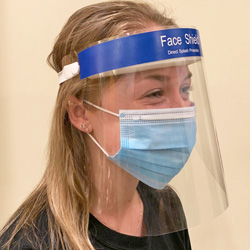NOT FOR DISTRIBUTION. Thanks!
I visited the explosion site yesterday. In my estimation, this could h
ave been much worse. Luckily it was not and it sounds like everyone will be
OK. The MU EHS folks I met were professional and seemed quite compete
nt. It appeared to me that the university was moving proactively
on rebuilding the lab. I saw nothing that gave me concern for my safety wh
ile I was there.
Here's the latest report I've seen:
Moving now to generalities:
It can be easy in ANY university lab to become complacent to the dange
rs in the area. It is easy to forget how hazardous the pressure in a g
as cylinder can be, or that the gas itself can be flammable, toxic, co
rrosive etc. when it is inconspicuous sitting in its cylinder in the c
orner. The same goes for the many liquids and solids we keep on the la
b bench, cabinets and desktops, often in breakable glass containers. &
nbsp;All of these become significantly more dangerous during a fire, explos
ion, tornado, earthquake, etc when they can also become projectiles.
Thorough training (documented) and communication of hazards
and procedures can help to combat complacency, but it's important to k
eep in mind that students and researchers can have a lot of things on their
minds and distractions, and one mistake can have significant repercus
sions. Safety has to be an integral part of what we communicate to st
udents, faculty, and staff.
Keep in mind that gas manufacturers can pre-mix to specifications, all
owing much tighter controls on the gas makeup - and from there, tighter con
trol of the atmosphere inside a glove bag, hood, or oth
er gastight enclosure. It is a good idea to thoroughly flush an enclos
ure with a neutral gas, like Nitrogen, before adding any potentially f
lammable components, exposing the gas mix to the atmosphere outsi
de the bag, and/or after use -always vent to a fume hood, not the room! If you choose to mix the gases yourself, it is often wise to mi
x in flammables last - but getting a premix from a specialty gas lab is a h
eckuva lot easier, and far more cost effective than an incident.
Lastly, These incidents are always a reminder to review your emergency
procedures with everyone who may work in a lab, so that they are all aware
of the hazards and what to do in case of an emergency.
Todd Perkins
--- On Tue, 6/29/10, Erik A. Talley <ert2002**At_Symbol_Here**MED.CORNELL.
EDU> wrote:
From: Erik A. Talley <ert2002**At_Symbol_Here**MED.CORNELL.EDU&
gt;
Subject: Re: [DCHAS-L] University of MO Lab Explosion
To: DCHAS-L
**At_Symbol_Here**LIST.UVM.EDU
Date: Tuesday, June 29, 2010, 5:49 PM
From: Erik A. Talley [mailto:ert2002**At_Symbol_Here**med.cornell.edu]
Sent: T
uesday, June 29, 2010 9:50 AM
To: 'DCHAS-L Discussion List'
Subject: University of MO Lab Explosion
Here is some informati
on about the University of Missouri laboratory explosion yesterday, includi
ng a video of the injured and a photo from inside the lab building:<
/DIV>
University of Missouri
press release:
http://munews.missouri.edu/news-releases/2010/0628-statement-3/
Video:
http://www
.ky3.com/news/local/97338759.html
Lab picture (provided
by the local fire department):
http://www.kmox.com/4-hurt-in-explosion-at-Mizzou-building/757
4837
CNN Article:
http://www.cnn.com/2010/US/06/29/missouri.university.explosion/
__________________
__________
Erik A. Talley, Director
Environmental Health and SafetyWeill Cornell Medical College
Cornell University
402 East 67th Stre
et, Room LA-0020
New York, NY 10065
646-962-7233
ert2002**At_Symbol_Here**med.cornell.ed
u
http://weill.cornell.e
du/ehs
| 